Ye Mao
Stereo Any Video: Temporally Consistent Stereo Matching
Mar 07, 2025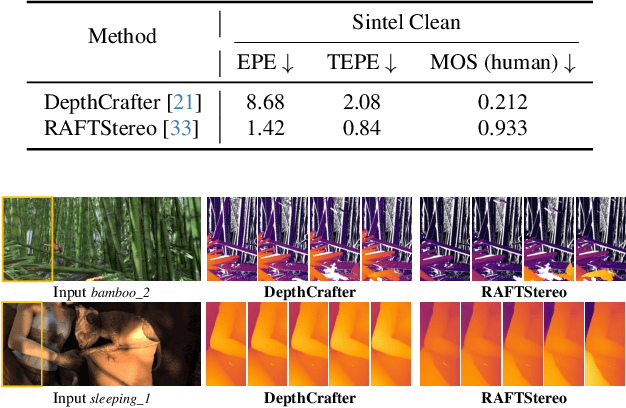
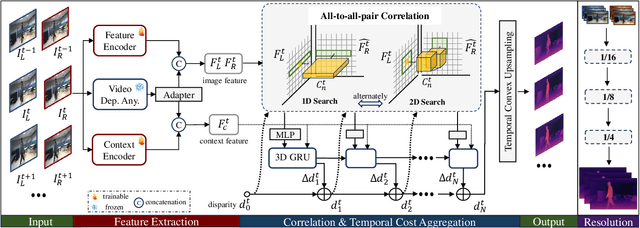


Abstract:This paper introduces Stereo Any Video, a powerful framework for video stereo matching. It can estimate spatially accurate and temporally consistent disparities without relying on auxiliary information such as camera poses or optical flow. The strong capability is driven by rich priors from monocular video depth models, which are integrated with convolutional features to produce stable representations. To further enhance performance, key architectural innovations are introduced: all-to-all-pairs correlation, which constructs smooth and robust matching cost volumes, and temporal convex upsampling, which improves temporal coherence. These components collectively ensure robustness, accuracy, and temporal consistency, setting a new standard in video stereo matching. Extensive experiments demonstrate that our method achieves state-of-the-art performance across multiple datasets both qualitatively and quantitatively in zero-shot settings, as well as strong generalization to real-world indoor and outdoor scenarios.
Hypo3D: Exploring Hypothetical Reasoning in 3D
Feb 04, 2025



Abstract:The rise of vision-language foundation models marks an advancement in bridging the gap between human and machine capabilities in 3D scene reasoning. Existing 3D reasoning benchmarks assume real-time scene accessibility, which is impractical due to the high cost of frequent scene updates. To this end, we introduce Hypothetical 3D Reasoning, namely Hypo3D, a benchmark designed to evaluate models' ability to reason without access to real-time scene data. Models need to imagine the scene state based on a provided change description before reasoning. Hypo3D is formulated as a 3D Visual Question Answering (VQA) benchmark, comprising 7,727 context changes across 700 indoor scenes, resulting in 14,885 question-answer pairs. An anchor-based world frame is established for all scenes, ensuring consistent reference to a global frame for directional terms in context changes and QAs. Extensive experiments show that state-of-the-art foundation models struggle to reason in hypothetically changed scenes. This reveals a substantial performance gap compared to humans, particularly in scenarios involving movement changes and directional reasoning. Even when the context change is irrelevant to the question, models often incorrectly adjust their answers.
Match Stereo Videos via Bidirectional Alignment
Sep 30, 2024


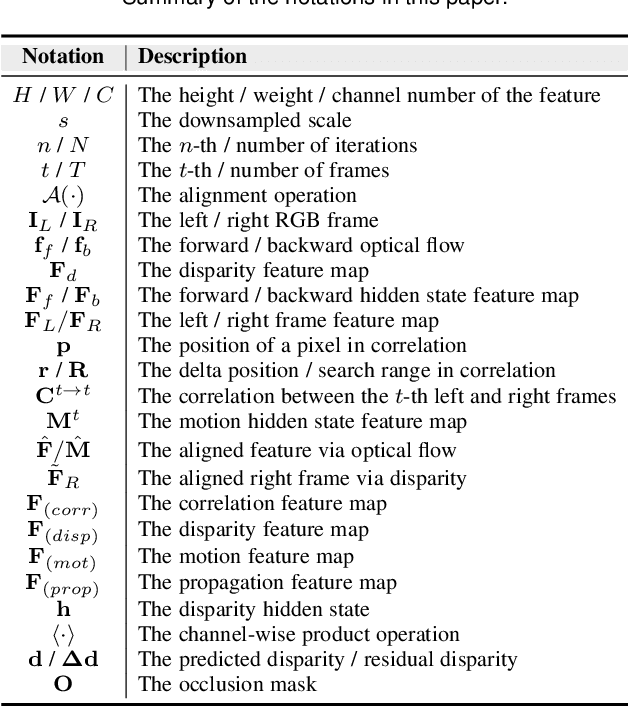
Abstract:Video stereo matching is the task of estimating consistent disparity maps from rectified stereo videos. There is considerable scope for improvement in both datasets and methods within this area. Recent learning-based methods often focus on optimizing performance for independent stereo pairs, leading to temporal inconsistencies in videos. Existing video methods typically employ sliding window operation over time dimension, which can result in low-frequency oscillations corresponding to the window size. To address these challenges, we propose a bidirectional alignment mechanism for adjacent frames as a fundamental operation. Building on this, we introduce a novel video processing framework, BiDAStereo, and a plugin stabilizer network, BiDAStabilizer, compatible with general image-based methods. Regarding datasets, current synthetic object-based and indoor datasets are commonly used for training and benchmarking, with a lack of outdoor nature scenarios. To bridge this gap, we present a realistic synthetic dataset and benchmark focused on natural scenes, along with a real-world dataset captured by a stereo camera in diverse urban scenes for qualitative evaluation. Extensive experiments on in-domain, out-of-domain, and robustness evaluation demonstrate the contribution of our methods and datasets, showcasing improvements in prediction quality and achieving state-of-the-art results on various commonly used benchmarks. The project page, demos, code, and datasets are available at: \url{https://tomtomtommi.github.io/BiDAVideo/}.
OpenDlign: Enhancing Open-World 3D Learning with Depth-Aligned Images
Apr 25, 2024Abstract:Recent advances in Vision and Language Models (VLMs) have improved open-world 3D representation, facilitating 3D zero-shot capability in unseen categories. Existing open-world methods pre-train an extra 3D encoder to align features from 3D data (e.g., depth maps or point clouds) with CAD-rendered images and corresponding texts. However, the limited color and texture variations in CAD images can compromise the alignment robustness. Furthermore, the volume discrepancy between pre-training datasets of the 3D encoder and VLM leads to sub-optimal 2D to 3D knowledge transfer. To overcome these issues, we propose OpenDlign, a novel framework for learning open-world 3D representations, that leverages depth-aligned images generated from point cloud-projected depth maps. Unlike CAD-rendered images, our generated images provide rich, realistic color and texture diversity while preserving geometric and semantic consistency with the depth maps. OpenDlign also optimizes depth map projection and integrates depth-specific text prompts, improving 2D VLM knowledge adaptation for 3D learning efficient fine-tuning. Experimental results show that OpenDlign significantly outperforms existing benchmarks in zero-shot and few-shot 3D tasks, exceeding prior scores by 8.0% on ModelNet40 and 16.4% on OmniObject3D with just 6 million tuned parameters. Moreover, integrating generated depth-aligned images into existing 3D learning pipelines consistently improves their performance.
Match-Stereo-Videos: Bidirectional Alignment for Consistent Dynamic Stereo Matching
Mar 16, 2024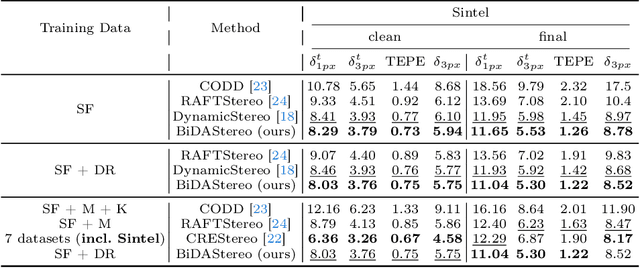


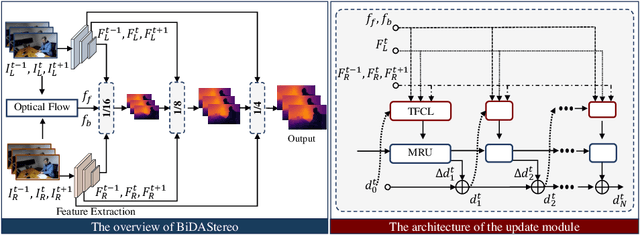
Abstract:Dynamic stereo matching is the task of estimating consistent disparities from stereo videos with dynamic objects. Recent learning-based methods prioritize optimal performance on a single stereo pair, resulting in temporal inconsistencies. Existing video methods apply per-frame matching and window-based cost aggregation across the time dimension, leading to low-frequency oscillations at the scale of the window size. Towards this challenge, we develop a bidirectional alignment mechanism for adjacent frames as a fundamental operation. We further propose a novel framework, BiDAStereo, that achieves consistent dynamic stereo matching. Unlike the existing methods, we model this task as local matching and global aggregation. Locally, we consider correlation in a triple-frame manner to pool information from adjacent frames and improve the temporal consistency. Globally, to exploit the entire sequence's consistency and extract dynamic scene cues for aggregation, we develop a motion-propagation recurrent unit. Extensive experiments demonstrate the performance of our method, showcasing improvements in prediction quality and achieving state-of-the-art results on various commonly used benchmarks.
Knowledge Distilled Ensemble Model for sEMG-based Silent Speech Interface
Aug 07, 2023
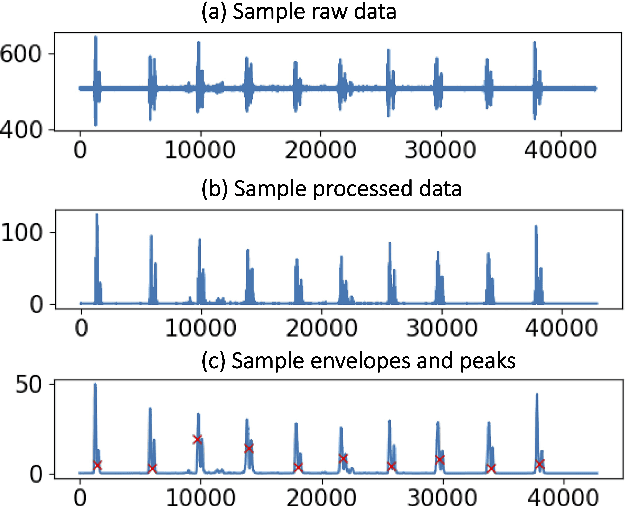
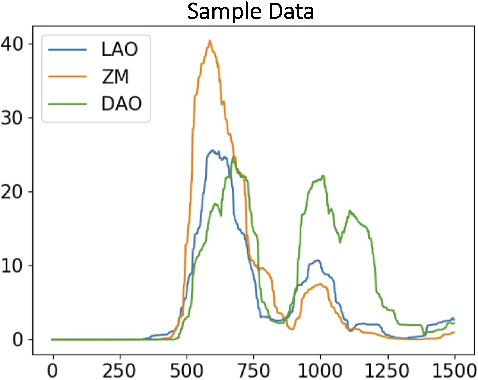
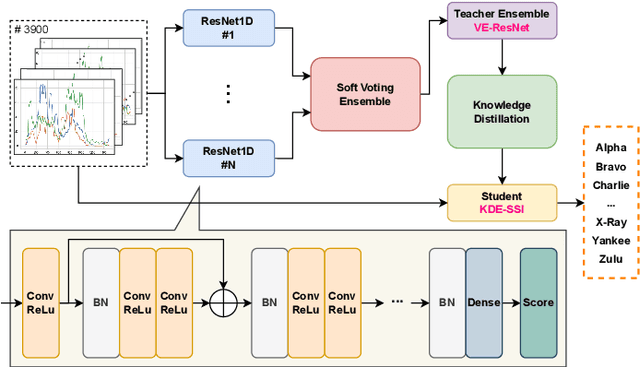
Abstract:Voice disorders affect millions of people worldwide. Surface electromyography-based Silent Speech Interfaces (sEMG-based SSIs) have been explored as a potential solution for decades. However, previous works were limited by small vocabularies and manually extracted features from raw data. To address these limitations, we propose a lightweight deep learning knowledge-distilled ensemble model for sEMG-based SSI (KDE-SSI). Our model can classify a 26 NATO phonetic alphabets dataset with 3900 data samples, enabling the unambiguous generation of any English word through spelling. Extensive experiments validate the effectiveness of KDE-SSI, achieving a test accuracy of 85.9\%. Our findings also shed light on an end-to-end system for portable, practical equipment.
DisC-Diff: Disentangled Conditional Diffusion Model for Multi-Contrast MRI Super-Resolution
Mar 24, 2023

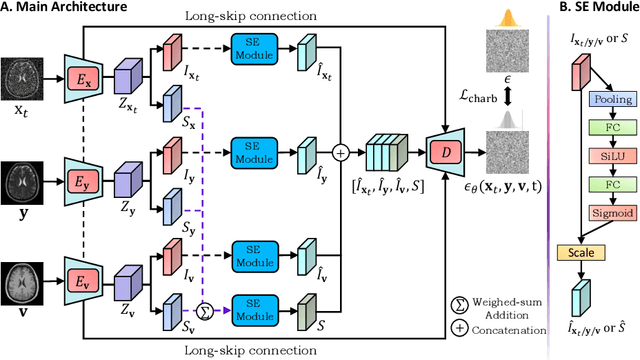

Abstract:Multi-contrast magnetic resonance imaging (MRI) is the most common management tool used to characterize neurological disorders based on brain tissue contrasts. However, acquiring high-resolution MRI scans is time-consuming and infeasible under specific conditions. Hence, multi-contrast super-resolution methods have been developed to improve the quality of low-resolution contrasts by leveraging complementary information from multi-contrast MRI. Current deep learning-based super-resolution methods have limitations in estimating restoration uncertainty and avoiding mode collapse. Although the diffusion model has emerged as a promising approach for image enhancement, capturing complex interactions between multiple conditions introduced by multi-contrast MRI super-resolution remains a challenge for clinical applications. In this paper, we propose a disentangled conditional diffusion model, DisC-Diff, for multi-contrast brain MRI super-resolution. It utilizes the sampling-based generation and simple objective function of diffusion models to estimate uncertainty in restorations effectively and ensure a stable optimization process. Moreover, DisC-Diff leverages a disentangled multi-stream network to fully exploit complementary information from multi-contrast MRI, improving model interpretation under multiple conditions of multi-contrast inputs. We validated the effectiveness of DisC-Diff on two datasets: the IXI dataset, which contains 578 normal brains, and a clinical dataset with 316 pathological brains. Our experimental results demonstrate that DisC-Diff outperforms other state-of-the-art methods both quantitatively and visually.
CoLa-Diff: Conditional Latent Diffusion Model for Multi-Modal MRI Synthesis
Mar 24, 2023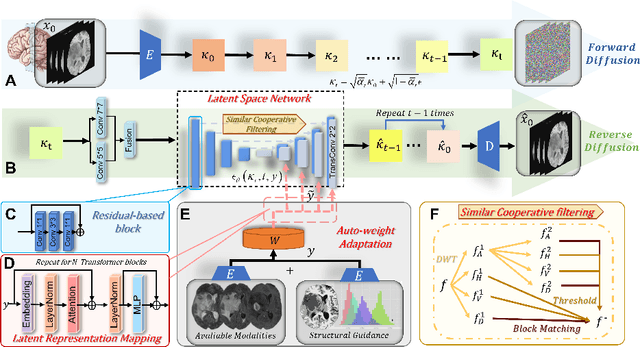
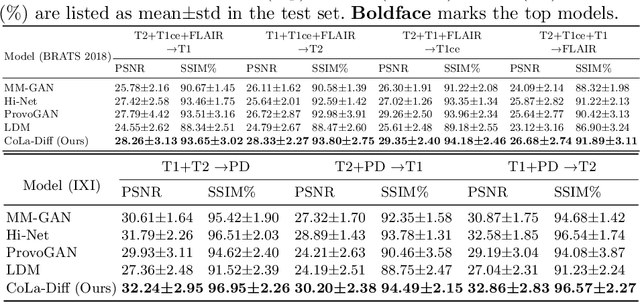
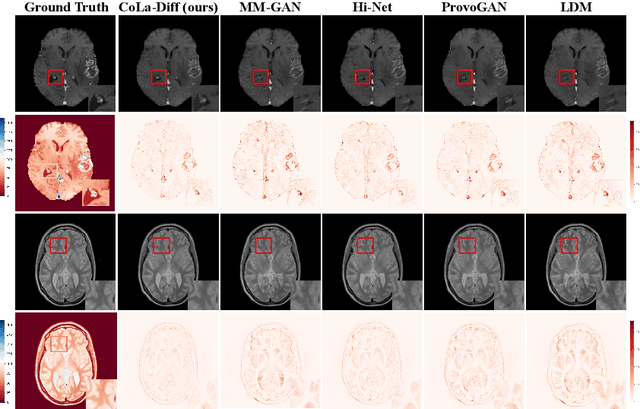
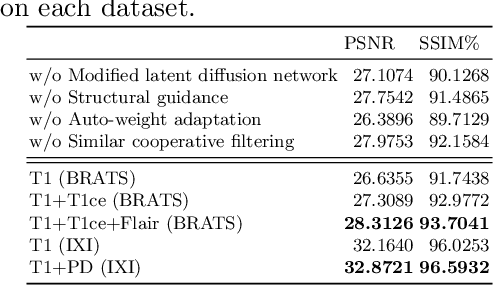
Abstract:MRI synthesis promises to mitigate the challenge of missing MRI modality in clinical practice. Diffusion model has emerged as an effective technique for image synthesis by modelling complex and variable data distributions. However, most diffusion-based MRI synthesis models are using a single modality. As they operate in the original image domain, they are memory-intensive and less feasible for multi-modal synthesis. Moreover, they often fail to preserve the anatomical structure in MRI. Further, balancing the multiple conditions from multi-modal MRI inputs is crucial for multi-modal synthesis. Here, we propose the first diffusion-based multi-modality MRI synthesis model, namely Conditioned Latent Diffusion Model (CoLa-Diff). To reduce memory consumption, we design CoLa-Diff to operate in the latent space. We propose a novel network architecture, e.g., similar cooperative filtering, to solve the possible compression and noise in latent space. To better maintain the anatomical structure, brain region masks are introduced as the priors of density distributions to guide diffusion process. We further present auto-weight adaptation to employ multi-modal information effectively. Our experiments demonstrate that CoLa-Diff outperforms other state-of-the-art MRI synthesis methods, promising to serve as an effective tool for multi-modal MRI synthesis.
 Add to Chrome
Add to Chrome Add to Firefox
Add to Firefox Add to Edge
Add to Edge